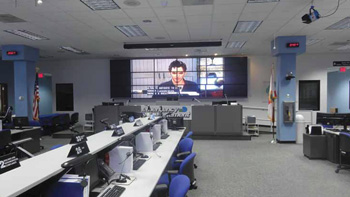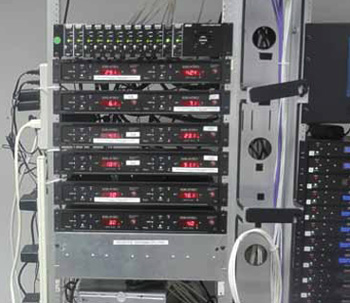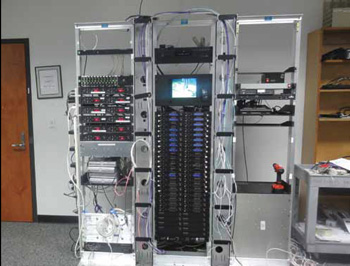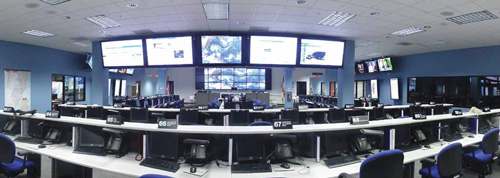Miami-Dade EOC is Newly Digital and Configured by In-House Staff.
The Miami-Dade County Emergency Operations Center (EOC) is the command and control center for this extreme Florida weather hotspot. In the event of an actual emergency, this facility is where representatives from each county agency, and partners from other state agencies and private entities, gather to help orient the county’s response to a disaster.
Switch to Digital
Because of the federally mandated transition to all digital broadcast, deputy director of emergency management, Jonathan Lord, and emergency management specialist, Adam Cohen, started looking at their existing broadcast infrastructure last year. “We needed to become an all-digital platform here at the facility,” said Lord. “And we needed to figure out how we would install and maintain it on our own.” He had experience with the Contemporary Research 232-ATSC HDTV Tuners, but Lord was certain about the facility’s choice when the product reconnaissance all came back to Contemporary Research. “We decided to rebuild our entire analog cable plant with an all-digital plant utilizing the Contemporary Research equipment: the QMOD-HDSC HD Scaler Modulators as well as the QCA-9-33 active RF combiners,” he said. “It was a multiphase process.”

The Miami-Dade County Emergency Operations
Center is where representatives from each county
agency, and partners from other state agencies and
private entities, gather to help orient the county’s
response to a disaster. Reliable 24/7
operation of thefacility’s broadcast system is a requirement. Over five phases, Lord and Cohen replaced a 20- to 30-channel analog system with a 20- to 30-channel digital system. The first steps of the multi-phase process were replacing the legacy analog with digital versions at higher resolutions. “We’re looking to ultimately go to an 80-channel, all digital system with added features and capabilities that we never had in the old analog system,” said Lord. “We’re looking at bringing in the feeds from the traffic cameras and other feeds from our mobile IPTV system that is turned up during certain emergencies and disasters.” Once the OEC goes digital, mobile feeds and webcam-based feeds can be distributed to multiple recipients in the facility over this system, as opposed to having individual unique instances of those in every office and every work area.
What is Being Broadcast?
In the EOC, news channels are usually broadcast on the flat panels. “During disasters, we reproduce status boards on the displays with information that is assembled here, along with maps made by Geographic Information Systems,” said Cohen. “That signal is sent out across the cable systems so different emergency offices can see the status of events going on in a disaster.” Having the media feeds and the dissemination of information on the status boards around the facility is key so that emergency staff can properly do their jobs. “If certain entities are working on evacuations, they’ll see that related information on the status board, no matter where they are in the facility,” said Lord. “It’s all very important to have them do their job safely and efficiently.”

Ease of use and of adaptability were keys to this upgrade. Miami-Dade EOC deputy director of emergency management, Jonathan Lord, says that the facility’s network is now future-proof. Years from now, if there is a new team in charge of the AV and IT, they could figure out how the system was implemented and how it could be upgraded, without extraneous effort.

Lord and Cohen at the EOC have been slowly migrating to the digital platform while keeping a few legacy analog channels up. “We prioritized where we replaced the televisions first,” said Lord. “In the main operations center, we went to all digital early on. For the status boards, we could transition earlier instead of later. But the news feeds are pumping information and some of their televisions were analogs so we kept some analog channels on until we could transition them over.” It was convenient for Lord and Cohen to be able to mix their legacy analog system with the growing digital system. Over a set of phases, as they turned off more analog channels, they turned on more digital channels.

This conversion to digital is the first overhaul of the system since it was originally installed for the EOC when the facility was built in 2000. “We wanted to make sure that our existing staff could run the system. We couldn’t go hire an integrator every time we wanted to change something on the system,” said Lord. “We have the ability to change channels and sources on the fly with the agile modulators from Contemporary Research. The simple connections between the sources are easy enough for someone with limited knowledge in this field, such as ourselves, to work with.”
With a little reading of the manuals and a few phone calls to Contemporary Research’s technical support, the EOC team was able to fully operate the system. In the future, they can continue to go along this path when it is time to upgrade capabilities.
Joy Zaccaria is a freelance writer/editor with more than a decade of experience covering the AV and communications industies. Is your facility also migrating to digital? Share your story by emailing AVTintern@nbmedia.com.
Equipment List
- * 16 Contemporary Research QMOD-HD Agile Clear QAM HDTV Modulators
- * 16 Contemporary Research QMOD-HDSC Agile Clear QAM HDTV Modulators
- * 8 Contemporary Research 232-ATSC+ Tuners
- * 9 Contemporary Research QCA-9-33 Active Combiners
- * 3 Contemporary Research PS12-4Y 4-Way Power Supplies
- * Plus all of the corresponding rack kits associated with each model
Key Elements / / /for the End-User
Network Impact:
It has had zero impact on our network. The IPTV system that we will eventually add as an enhancement running over our network might make a difference. But our network is already built to handle that. It’s really the co-ax side of things that we are changing. We already had a good RG6 distribution system here. The Contemporary Research equipment integrated so nicely with what we already had here. So we only had to focus on the head end because it didn’t require changing anything else in the distribution side.
ROI:
The justification of the investment is that the network is future-proof. Three or four years from now, if there is a new team in charge of the AV and IT here, with the same amount of effort and research, they could figure out how we implemented all this on our own. And then to change the system, they could figure it out themselves as well. That was key to the process. What we came up with could be replicated by somebody else with the same kind of drive without having to hire someone to build the system for them.
Ease-of-Use:
We did not have to hire an integrator to do this. That was really key and that is why we kept coming back to the Contemporary Research products. In today’s fiscal climate, to be able to manage the systems and installations ourselves without having to have the technical expertise, that went a long way in focusing on the Contemporary Research product line.
Reliability:
We did have to call Contemporary Research with some technical questions. They were very understanding and walked us through the system. Aside from that, their products have all been very user-friendly.
—Jonathan Lord
